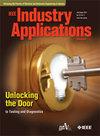CM Noise Modeling and Reduction for Multi-Output Dual-Switch Flyback Auxiliary Power Supplies
IF 4.2
2区 工程技术
Q2 ENGINEERING, ELECTRICAL & ELECTRONIC
引用次数: 0
Abstract
The multi-output dual-switch flyback converter is extensively used as an auxiliary power supply in high-voltage and high-power photovoltaic (PV) inverters, providing power to electronic circuits. To maintain an independent power supply, isolation between the multiple outputs is necessary. However, when developing a common-mode (CM) model for the multi-output flyback converter as an independent system, neglecting the isolation between the multiple outputs renders the model incapable of accurately describing the CM electromagnetic interference (EMI) emission characteristics within the inverter system. To resolve this issue, this paper proposes a CM model for the multi-output flyback converter that effectively represents its CM EMI emission characteristics when used as an auxiliary power supply in an inverter system. First, a complete CM noise path model for the multi-output dual-switch flyback auxiliary power supply is established using the lumped capacitance model for isolating multiple outputs in transformers. Given the numerous lumped capacitors in the transformer's CM model, the “insertion capacitance method” has been proposed to accurately and reliably extract these capacitances. Subsequently, a capacitance designed for CM noise mitigation is implemented and adjusted to create a reverse extraction current, which offsets the generated CM noise. The established CM model accurately characterizes the transmission of CM EMI from the flyback auxiliary power supply through multiple output paths to other parts of the PV inverter. The effectiveness of this approach is validated on an experimental platform of a PV inverter.求助全文
约1分钟内获得全文
求助全文
来源期刊

IEEE Transactions on Industry Applications
工程技术-工程:电子与电气
CiteScore
9.90
自引率
9.10%
发文量
747
审稿时长
3.3 months
期刊介绍:
The scope of the IEEE Transactions on Industry Applications includes all scope items of the IEEE Industry Applications Society, that is, the advancement of the theory and practice of electrical and electronic engineering in the development, design, manufacture, and application of electrical systems, apparatus, devices, and controls to the processes and equipment of industry and commerce; the promotion of safe, reliable, and economic installations; industry leadership in energy conservation and environmental, health, and safety issues; the creation of voluntary engineering standards and recommended practices; and the professional development of its membership.
 求助内容:
求助内容: 应助结果提醒方式:
应助结果提醒方式:


